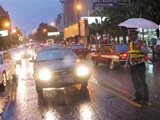 The recent boom in private cars in Beijing has triggered debate over whether their numbers should be limited for fear of worsening traffic.
The recent boom in private cars in Beijing has triggered debate over whether their numbers should be limited for fear of worsening traffic.
The number of motor vehicles in Beijing has reached 1.88 million, with an increase of 190,000 in the first 11 months of this year. And Beijing has far more private cars on the road than any other city -- 800,000, about 400,000 more than Guangzhou, which ranks second in private vehicle numbers.
While people in Beijing are happy about the greater choice of cars available, they worry that the ongoing car boom might cause too many traffic jams and inconvenience.
The first response of many is to limit the number of cars and to build more roads.
Yet compared with the 4 million cars in Tokyo and New York, Beijing's 1.88 million cars do not seem too many. Actually, Beijing has the widest and longest ring roads in China.
With the completion of new ring roads, people had hoped that the problem would ease a little. For example, the sixth ring road around the city -- the longest of its kind in the country -- is under construction now.
But the roads and related infrastructure never seem to keep pace with the traffic. Statistics released by the municipal government show that in the past 10 years the number of cars has doubled, while road infrastructure has increased by only 30 percent.
The traffic problem in Beijing today has its roots in history.
"The layout of ancient Beijing, which developed at the time of the wagon and sedan (traditional means of transportation), ended roads at big compounds or scenic sights," said Liu Xiaoming, vice-president of Beijing Polytechnic University.
"But as modern transportation led people further away from the limited old city area, the once ideal urban design fell short of our needs," he said.
Shi Qixin, director of the Institute of Transportation Engineering, agreed that the problem lies in the city's urban planning.
"The impractical design of roads, including the design of entrances and exits, location of bus stops, and traffic lights at crossroads, all contribute to the congestion," Shi said.
Liu, who is now responsible for the Intelligent Transport Systems layout for Beijing, suggests that optimizing the city's planning, developing public transport and guiding the proper use of private cars is the way forward.
Ma Lin, senior engineer with the Urban Transport Institute of the China Academy of Urban Planning and Design, also believes that there is no need to limit private car numbers.
"I moved to Beijing in the late 1970s. With only tens of thousands of cars, there was congestion in Beijing already," Ma said.
"Traffic jams are just normal. The point is that we should improve the road network and management."
Growth in private car ownership is an irreversible trend, Ma said.
"Limiting the number of cars by administrative order won't work."
The municipal government shares that opinion, adopting a policy of easing traffic pressure by improving public transport instead of cracking down on private cars.
The road resource needed by public transport is only about one-twentieth of that required by cars. And rail transport, including subway and light rail, is a faster, cleaner and more economical form of public transport that can best solve the problem of limited road resources.
Liu said: "For super-large and densely populated cities such as Paris and Tokyo, rail-based transit is always the backbone of the whole transport system."
"It normally carries 40 percent of daily commuters. But in Beijing, the proportion is only 5 percent. There is a lot of potential."
Based on the Beijing Olympic Action Plan, the Transport Construction and Traffic Management Plan (Draft) was released for comment early this month. The layout gives priority to public transport and modern logistics systems, aiming at providing convenient, fast and environmentally-friendly transport services.
By the year of 2008, Beijing's urban railway lines will exceed 300 kilometers in length. It is expected to carry 1.8 to 2.2 billion passenger trips per year.
The capacity of Beijing's buses and trolley bus transport will reach 4.5 billion passenger trips per year.
With railway transport as the backbone and buses and trolley buses as the mainstay, the public transport system will carry up to 60 percent of daily commuters, upgrading its share in total daily trips from 26 percent to 40 percent, according to the plan.
But will Beijing be able to accommodate the estimated 3 million vehicles in 2008? Experts are optimistic about the answer.
Shi said: "The well-developed public transport will guide people to use their private cars properly. In big cities like Tokyo, people choose public transport for daily commuting because it's more convenient.
"Other measures, like increasing parking fees and other expenses, can be introduced. In London, for example, they will even impose a 'congestion charge' on the cars going into the city's central zone during certain hours."
Ma agreed: "When convenient and cost-effective public transport is available, even private car owners consider it an attractive alternative and make their choice more wisely."
(China Daily December 13, 2002)
|

